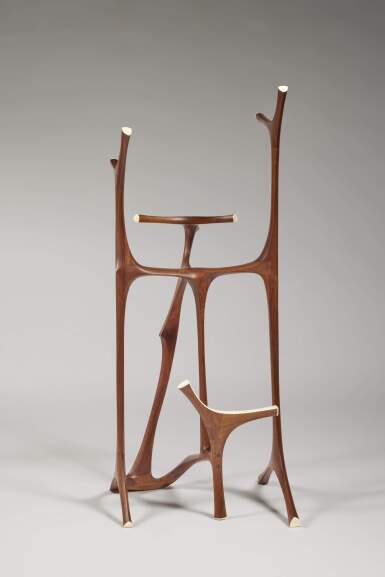
Wendell Castle
"Stool Sculpture"
Auction Closed
June 10, 03:47 PM GMT
Estimate
200,000 - 300,000 USD
Lot Details
Description
Wendell Castle
"Stool Sculpture"
1959
walnut, ivorine
monogrammed WC and dated 59
61 x 25 x 36 in. (154.9 x 63.5 x 91.4 cm)
Acquired from the above by the present owner
Mid-America Exhibition, Nelson-Atkins Museum of Art, Kansas City, MO, March 31-April 30, 1960
Sculpture in Wood and Copper by Wendell Castle, Little Gallery Frame Shop, Westwood Hills, KS, July-August, 1960
Furniture by Wendell Castle, Detroit Institute of Arts, Detroit, MI, December 5, 1989-February 4, 1990, Delaware Art Museum, Wilmington, DE, March 9-May 13, 1990, Virginia Museum of Fine Arts, Richmond, VA, June 19-August 19, 1990, Memorial Art Gallery, University of Rochester, Rochester, NY, November 17, 1990-January 20, 1991, American Craft Museum, New York, NY, February 14-April 30, 1991
Wendell Castle: Wandering Forms-Works from 1959-1979, The Aldrich Contemporary Art Museum, Ridgefield, CT, October 19, 2012-February 20, 2013
Wharton to Wendell, Modernism Museum Mount Dora, Mount Dora, FL, October 6, 2013-September 2014
Bill Ferguson, "Furniture Fantastique: Art Furniture, Designer Wendell Castle's Sought-After Creations Defy Traditional Definitions," Syracuse Herald-Journal, Syracuse, NY, April 25, 1988 (for the present lot illustrated)
Sebby Wilson Jacobson, "Wendell Castle Furnishes Nation with New 20th-Century Art Form," Kansas City Alumni Magazine, Kansas City, MO, June 1989, n.p. (for the present lot illustrated)
"Entertainbeat: Wendell Castle Furnishes the DIA with an Exhibit," Detroit News, Detroit, MI, July 11, 1989 (for the present lot illustrated)
"Art," Michigan Magazine (Detroit News), Detroit, MI, September 17, 1989, n.p. (for the present lot illustrated)
Sally Vallongo, "Wendell Castle Takes an Artistic View of Furniture," The Blade, Toledo, OH, December 17, 1989, n.p. (for the present lot illustrated)
Davira S. Taragin, Edward S. Cooke, Jr., and Joseph Giovannini, Furniture by Wendell Castle, New York, 1989, p. 21 (for the present lot illustrated)
Sebby Wilson Jacobson, "The Roots of Wendell Castle," Democrat and Chronicle, Rochester, NY, November 15, 1990, n.p. (for the present lot illustrated)
Ron Netsky, "Carving Out a Career: Retrospective Surveys Art of Wendell Castle, Democrat and Chronicle, Rochester, NY, December 23, 1990, n.p. (for the present lot illustrated)
"Featured Exhibition: Furniture by Wendell Castle," Delaware Art Museum Quarterly, Delaware, Winter 1990, n.p. (for the present lot illustrated)
Patricia Conway, Art for Everyday: The New Craft Movement, New York, 1990, p. 256 (for the present lot illustrated)
Alastair Gordon, Wendell Castle: Wandering Forms - Works from 1959-1979, exh. cat., The Aldrich Contemporary Art Museum, Ridgefield, Connecticut, 2012, pp. 30-31 (for period photographs of the present lot exhibited at the Nelson-Atkins Museum of Art, Kansas City, 1960) and 32-33 (for the present lot illustrated)
Emily Evans Eerdmans, Wendell Castle: A Catalogue Raisonné, 1958–2012, New York, 2014, pp. 16 and 57, no. I.24 (for the present lot illustrated)
Stool Sculpture is a piece of the true cross: a precious relic of Wendell Castle’s first artistic breakthrough. No object that he made in the course of his seven-decade career, indeed, no work made in the whole postwar American craft movement, is more historically significant.
To set the scene: the year was 1959, and Castle was still at the University of Kansas, studying sculpture. He’d been making furniture in his studio for his own use, which drew the ire of one of his instructors – this was meant to be a sculpture program, after all. Castle was enough of a contrarian that he got to wondering: What if I did both furniture and sculpture, and at the same time? Stool Sculpture was the result. Though it is an entirely successful abstract composition, you can also imagine perching on it, hooking your heels over the footrest.
Made of salvaged gunstock blanks from a local armory and originally inlaid with ivory (since replaced with a substitute material), Stool Sculpture is a delicate and refined object. Yet what power it holds: even in its title, it captures the collision of two categories that, at the time, were held rigidly separate. And what happens when two things collide, approaching one another across a distance? Everything ends up in a new, more complicated, more exciting configuration. As Castle put it many years later, “This was [when] those hybrid things didn't exist like they do now. They’re all over the place.”1 This is exactly right: Stool Sculpture instantly positioned Castle within a small avant garde of artists, whose experiments would thoroughly reshape the possibilities for craft mediums. (Among them was Peter Voulkos, whose own breakthrough works were unfolding exactly at the same moment out in California.)
So novel was Castle’s innovation that it took him some time to grasp its implications. Stool Sculpture itself had a positive reception across disciplines: it immediately won a prize at a Kansas “Designer-Craftsman” annual show, and in 1960, was juried into an art exhibition at the Nelson-Atkins Museum. Castle did follow up with related works, too, notably the similarly proportioned Scribe’s Stool (1961-62). But it was not until he began using stack lamination – allowing him to work subtractively, a totally different process – that he would fully realize the sculptural possibilities he had unleashed. He would ultimately follow those prospects farther, and longer, than even he could have possibly dreamt. But it all started here.
[1] Oral history interview with Wendell Castle, June 3 and December 12, 1981. Archives of American Art, Smithsonian Institution.
GLENN ADAMSON
You May Also Like










